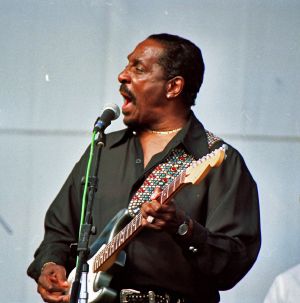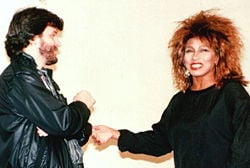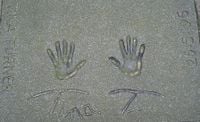Difference between revisions of "Tina Turner" - New World Encyclopedia
m (→External links) |
m (→External links) |
||
| Line 132: | Line 132: | ||
*[http://www.allmusic.com/cg/amg.dll?p=amg&sql=11:lmf8zffheh8k Tina Turner on all music guide] | *[http://www.allmusic.com/cg/amg.dll?p=amg&sql=11:lmf8zffheh8k Tina Turner on all music guide] | ||
*[http://www.youtube.com/watch?v=YFQlZht2DU4&feature=PlayList&p=35D7DA19A95AEB3D&playnext=1&index=19 Tina Turner sings "What's Love Got To Do With It"] | *[http://www.youtube.com/watch?v=YFQlZht2DU4&feature=PlayList&p=35D7DA19A95AEB3D&playnext=1&index=19 Tina Turner sings "What's Love Got To Do With It"] | ||
| − | [http://www.youtube.com/watch?v=4KkMSkmx7sM Ike and Tina Turner: "River Deep, Mountain High"] | + | *[http://www.youtube.com/watch?v=4KkMSkmx7sM Ike and Tina Turner: "River Deep, Mountain High"] |
| − | [http://www.youtube.com/watch?v=SI1EN6GCGc0 Ike and Tina Turner live medley] | + | *[http://www.youtube.com/watch?v=SI1EN6GCGc0 Ike and Tina Turner live medley] |
[[Category:music]] | [[Category:music]] | ||
Revision as of 23:21, 30 December 2008
| Tina Turner | |
|---|---|
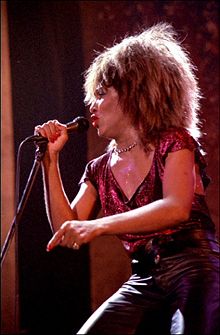 Tina Turner at a show in Norway in 1985
| |
| Background information | |
| Birth name | Anna Mae Bullock |
| Born | November 26 1939 (age 84) Nutbush, Tennessee, United States |
| Occupation(s) | Singer, songwriter, dancer, actress |
| Instrument(s) | Vocals |
| Voice type(s) | Contralto [1] |
| Years active | 1956–present |
| Label(s) | Capitol, EMI, Parlophone, Virgin |
| Associated acts |
Ike Turner, Ike and Tina Turner, Bryan Adams, David Bowie |
Tina Turner (born Anna Mae Bullock; November 26, 1939) is a muplitple Grammy Award-winning American singer-songwriter, dancer, author and actress, known as the "Queen of Rock & Roll." Her records have sold many millions of copies, and her energetic stage presence, powerful vocals, energetic dancing, and spectacular concerts have made her one of the most successful live performers in history.
Beginning her career as a rhythm and blues singer with her future husband Ike Turner, Tina had a string of hits in the 1960s and early 70s. Fading sales and her husband's drug problems led to a trouble married, which came to an abrupt in 1976, after which she struggled to rebuild her career. She stage one of the industry's most meteoric comebacks with the smash hit album Private Dancer in 1985. She went on to great success both as a recording artist and live performer. Her autobiography, I Tina was made into the feature film What's Love Got To Do With It?
Besides rock, she has also performed blues, R&B, soul, dance and pop music. Turner is represented in the Grammy Hall of Fame by two of her recordings: "River Deep - Mountain High" (1999) and "Proud Mary" (2003). She has accumulated many hit albums and singles worldwide both as a solo act and with former husband, Ike Turner, (as a member of the Ike & Tina Turner Revue). As a live performer, she is the successful female rock artist ever, having sold more concert tickets than any other solo performer in music history.
Early life
Turner was born Anna Mae Bullock in Nutbush, Tennessee on November 26, 1939, the daughter of Zelma (née Currie), a factory worker, and Floyd Richard Bullock, a Baptist deacon, farm overseer, and factory worker. Her mother was half Cherokee Indian, a quarter European, and a quarter African-American making Anna Mae a quarter Native American, an eighth caucasian, and nearly three quarters African-American.
Turner and her sister, Allene, grew up with their grandmother after their parents split when Turner was ten. They moved from Nutbush to St. Louis to reunite with their mother in 1956.
At age 16, Anna moved to St. Louis, Missouri, where she attended Sumner High School. In St. Louis, she met Mississippi-born rhythm and blues singer and recording artist Ike Turner and later asked him if she could sing for him. She became an occasional vocalist in Turner's shows at the age of 18.
Ike & Tina Turner Revue
In 1960, when a singer scheduled to record the song, "A Fool In Love," did not appear, Bullock stepped in and recorded the vocals instead. Pitched above her normal range "A Fool In Love" emphasized the raw emotion of her her vocal qualities and became a huge R&B hit, reaching number two and crossing over to the top 30 of the US pop chart. After this surprise success, Ike gave Bullock the stage name Tina (after Sheena: Queen of the Jungle) and dubbed his band the "The Ike & Tina Turner Revue." In 1962, the two married in Tijuana, Mexico.
Throughout the 1960s and into the 1970s, Ike and Tina enjoyed considerable stardom. Tina developed a unique stage persona, thrilling audiences with her powerful vocals and sexy, frenetic dancing. The Revue's backup singers, the Ikettes, wove intricate, electrifying dance routines, while Ike served as band-leader, guitarist, and occasional vocalist.
Ike and Tina Turner recorded a string of hits in the 1960s, including "A Fool In Love," "It's Gonna Work Out Fine," "I Idolize You," and the groundbreaking "River Deep, Mountain High." Ike played no active role in the latter hit, which was arranged and recorded by producer Phil Spector in his Wall of Sound style. By the end of the decade, the duo began including their interpretations of rock classics such as "Come Together," "Honky Tonk Woman," and their most successful record, Creedence Clearwater Revival's 1968 "Proud Mary," which reached number four in March, 1971 and remains Tina's signature song. The single won a Grammy for Best R&B Vocal Performance By A Duo or Group.
During this time, Tina raised four sons—Ike Jr. and Michael (from Ike's previous relationship), Craig (born 1958, Tina's son from an earlier relationship), and Ronald (he son with Ike, born 1961).
Although they remained a popular stage act much admired by rock icons like Mick Jagger, Janis Joplin, and Elvis Presley, Ike and Tina's success began to fade in the mid-70s. Tina's personal life and marriage also began to deteriorate, due in large part to Ike's drug use, which led to increasingly erratic and physically abusive behavior. Their last recording success was "Nutbush City Limits," a song penned by Tina about her home town, that reached number 22 in the and and number four in the UK in 1973.
Having opened his own recording studio - Bolic Sound - following the lucrative success of "Proud Mary," Ike produced Tina's first solo album, Tina Turns the Country On in 1974. It failed to make an impact on the charts, as did the follow-up, Acid Queen (1975), released to tie in with Tina's critically acclaimed big-screen debut in The Who's rock opera, Tommy.
After a vicious beating before an appearance in Dallas in 1976, Tina abruptly left Ike, fleeing with nothing more than 36 cents and a gas-station credit card. She spent the next few months hiding from Ike while staying with various friends and resorting to food stamps.
Tina credited her newfound Buddhist faith with giving her the courage eventually to strike out on her own. She was also legally responsible to tour promoters for the canceled tour. She thus became a solo performer, supplementing her income with TV appearances on shows such as The Hollywood Squares, Donny and Marie, The Sonny & Cher Show and The Brady Bunch Hour.
Her divorce was finalized in 1978 after 16 years of marriage. Her autobiography I, Tina detailing her life with Ike, was later made into the film What's Love Got to Do with It?. Retaining only her stage name, she assumed responsibility for the debts incurred by the canceled tour as well as a significant IRS lien.
Solo career
Rough (1978) was Tina's first album after her separation from Ike. It was a departure from the R&B sound of the Revue, signaling the direction in which she wished her musical career to progress. However, neither Rough nor 1979's Love Explosion, an attempt to attract the disco market, sold well. Turner began touring extensively around the world, enabling her to make a living, but her career stalled until 1982-83, as where her popularity stage in Europe gave her career a second life.
In December, 1983, her cover of Al Green's Let's Stay Together hit number six in the UK and became a hit across all of Europe. When Capitol Records, her new label, released the single in the US, it hit number 26 on the pop chartsand was an even bigger success on the R&B and Dance charts, reaching the Top 5 on both.
'Private Dancer'
In May, Capitol released the single "What's Love Got To Do With It?" in the US to promote an upcoming album. In June What's Love? was released to Europe it reached #3 in the U.K. and hit the Top 5 in many other countries. The album Private Dancer was released in the spring of 1984, peaking at number three on the US album chart and selling well throughout the year. It reached number one the US R&B album chart, remaining there for five week. In Europe the album was also a major hit, selling millions of additional copies. By mid-August, the single, "What's Love?," had reached number two in the US. When it hit number one in September, Tina Turner became the oldest person ever to have a number one hit (a record later broken by James Brown). The single "Better Be Good To Me" was Top 10 hit in most European countries and peaked at number on the US pop charts and number 6 on the R&B charts. The album remained in the Top 10 until May 1985.
At the end of 1984, Rolling Stone Magazine's critics' poll named her Artist of the Year, Female Vocalist of the Year, and R&B Artist of the Year, also awarding top honors for the year's best album and best single. Similar accolades came from Billboard Magazine and various other industry institutions.
In February of 1975, Tina started her highly successful Private Dancer Tour, which took her to the U.S., Europe, Australia, and Japan with over 170 dates. Her European tour broke box office records, her original 8 German dates were extended to over 30. At the 27th annual Grammy Awards in the same month, she won four Grammy Awards, receiving a standing ovation for her performance of '"What's Love?"
In March, "Private Dancer," the single, was released in the US where it reached number on seven the pop charts number three R&B. The Private Dancer album remains one of the best-selling albums of all time with sales of well over 10 million copies.
Subsequent success
After the success of Private Dancer, Turner accepted the role of Aunty Entity, the ruler of Bartertown, in the film Mad Max Beyond Thunderdome. Turner received the NAACP Image Award for Outstanding Actress for her role. In July, she performed at Live Aid alongside Mick Jagger. In August, the single "We Don't Need Another Hero" became yet another international smash hit for Turner reaching number two in America and number three in England. The song received a Grammy nomination for Best Female Pop Vocal and received a Golden Globe nomination for Best Original Song. In November, a new single was released entitled "It's Only Love," a duet with Bryan Adams. It received a Grammy nomination for Best Rock Performance by a Duo or Group with Vocal.
Turner continued her widely successful solo career releasing the album, Break Every Rule, in 1986, selling many millions of copies and performing to huge crowds—one estimated at a record-setting 184,000—in the subsequent tour.That same year, she published her autobiography, I, Tina and received a star on the Hollywood Walk of Fame. In April, 1988, Turner released a live double album, Tina Live in Europe, followed in 1989 by her seventh studio album, Foreign Affair, which included the international hit, "The Best". Her 1990 tour promoting the album featured 121 shows in Europe, beating attendance records set by The Rolling Stones' recent tours.
In 1991, Ike and Tina Turner were inducted into the Rock & Roll Hall of Fame, and Tina released a compilation album, Simply the Best. In 1993, autobiography was turned into a box-office film, What's Love Got to Do with It?, painting a dark picture of Turner's marriage her heroic emergence from it through her Buddhist faith. The film's leading actors, Angela Bassett and Laurence Fishburne, received Academy Award nominations for their roles. The soundtrack went platinum in America and yielded Turner's final top ten U.S. single, "I Don't Wanna Fight," which peaked at number nine. Later that year, Turner went out on a sold-out U.S. tour, her first in seven years, to promote the soundtrack. She moved to Switzerland and took a year off from the road at the end of the tour.
In 1995, Turner returned to recording with the title track for the James Bond flick, Goldeneye. In 1996, her Wildest Dreams album was released, selling well on the strength success of singles such as "Whatever You Want," "Something Beautiful Remains," and the duet with Barry White, "In Your Wildest Dreams." In May of 1996, Turner embarked on another successful, year-long world tour. In November of 1999, Turner released the dance single "When the Heartache Is Over." Its parent album, "Twenty Four Seven," was a success, but not a million-seller. Later that year, Turner, with Turner about to turn 60, the Twenty Four Seven Tour became the highest-grossing tour of 2000 with over $100 million in ticket sales. Guinness World Records later announced that Turner had sold more concert tickets than any other solo concert performer in music history.
Career hiatus
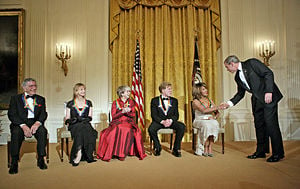
Over the next few years, Turner continued to occasional make public appearances and to collaborate with other musicians on recording projects. The 2004 album All The Best was a comprehensive collection including two discs and 33 tracks. It reach the Top 10 in several European countries. In early 2005, All The Best was released in the US, debuting at number two on the Billboard album charts and eventually selling over a million copies.
At the end of the year, Turner was recognized by the Kennedy Center Honors at the John F. Kennedy Center for the Performing Arts in Washington, D.C..
In May 2007, Tina returned to the stage to headline a benefit concert for the Cauldwell Children's Charity at London's Natural History Museum. This was her first full show in seven years.
On February 10, 2008, at age 68, Turner performed together with Beyoncé at the 50th Annual Grammy Awards that was broadcast live on CBS. In September of the same year, Turner released a new 18 track CD, Tina!: Her Greatest Hits, including several live recordings and two new tracks. In October 1, she began yet another world tour, beginning in Kansas City, Missouri, where she performed in front of a sold out crowd.
Discography
Studio albums
- 1973: Tina Turns the Country On
- 1975: Acid Queen
- 1978: Rough
- 1979: Love Explosion
- 1984: Private Dancer
- 1986: Break Every Rule
- 1989: Foreign Affair
- 1996: Wildest Dreams
- 1999: Twenty Four Seven
Tours
- 1978: Wild Lady of Rock Tour
- 1982: Nice 'n' Rough Tour
- 1985: Private Dancer Tour
- 1986: Break Every Rule Tour
- 1990: Foreign Affair Tour
- 1993: What's Love? Tour
- 1996: Wildest Dreams Tour
- 2000: Twenty Four Seven Tour
- 2008: Tina: Live in Concert Tour
Filmography
- The Big T.N.T. Show (1966) (documentary)
- It's Your Thing (1970) (documentary)
- Gimme Shelter (1970) (documentary)
- Taking Off (1971)
- Soul to Soul (1971) (documentary)
- Tommy (1975)
- Sgt. Pepper's Lonely Hearts Club Band (1978)
- Mad Max Beyond Thunderdome (1985)
- What's Love Got to Do with It (1993) (also singing voice for Angela Bassett)
- Last Action Hero (1993)
ReferencesISBN links support NWE through referral fees
External links
- Tina Turner official label website
- Tina Turner's U.S. Fansite
- Tina Turner on all music guide
- Tina Turner sings "What's Love Got To Do With It"
- Ike and Tina Turner: "River Deep, Mountain High"
- Ike and Tina Turner live medley
Credits
New World Encyclopedia writers and editors rewrote and completed the Wikipedia article in accordance with New World Encyclopedia standards. This article abides by terms of the Creative Commons CC-by-sa 3.0 License (CC-by-sa), which may be used and disseminated with proper attribution. Credit is due under the terms of this license that can reference both the New World Encyclopedia contributors and the selfless volunteer contributors of the Wikimedia Foundation. To cite this article click here for a list of acceptable citing formats.The history of earlier contributions by wikipedians is accessible to researchers here:
The history of this article since it was imported to New World Encyclopedia:
Note: Some restrictions may apply to use of individual images which are separately licensed.

